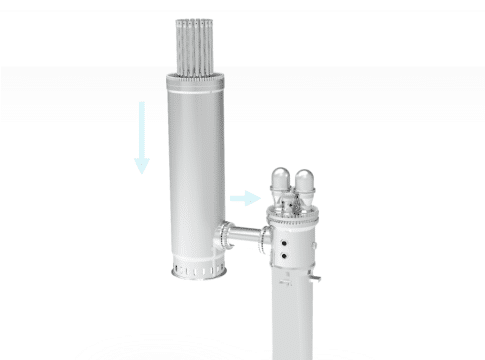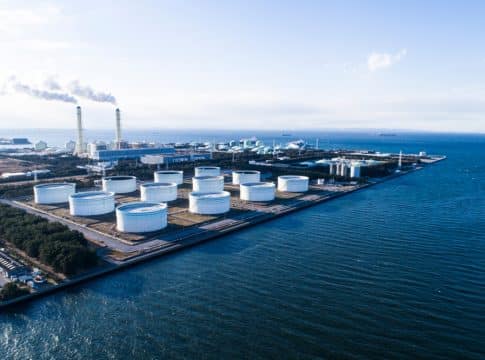Amazon Turns to Nuclear and SMRs For Its $52B Data Center Expansion
Amazon is diving deep into nuclear power as part of its ambitious data-center expansion plan, investing over $52 billion across three U.S. states. The e-commerce giant has inked 3 key deals to explore and develop small modular reactors (SMRs).
SMRs are a new type of nuclear technology that promises more efficient, compact, and clean power generation. AWS CEO Matt Garman noted that SMRs present unique potential to provide scalable and reliable power to meet the ever-growing energy needs of data centers.
Shares of nuclear companies surged following Amazon’s announcement of the agreements. Nano Nuclear Energy and Nuscale Power saw their shares rise nearly 10% in premarket trading, while Oklo experienced an over 11% increase.
RELATED: Are SMRs The Future of Nuclear Energy? Oklo Leads the Charge
Small Reactors, Big Ambitions
SMRs are advanced nuclear reactors designed to be less than 10% of the size of traditional nuclear plants. But they can generate up to about ⅓ of the power output of traditional reactors. As such, they allow for easier deployment and integration into the energy grid.
Developers aim to have these reactors generating electricity by the early 2030s, contingent on receiving approval from the Nuclear Regulatory Commission (NRC) to build and operate their designs, as well as proving the technology’s viability.
Amazon’s most recent collaboration with Dominion Energy, a $48 billion market-cap utility company, aims to explore the deployment of SMRs in Virginia near Dominion’s North Anna power station in Louisa County.
Virginia hosts nearly half of all U.S. data centers, with a significant concentration in Northern Virginia, particularly in the Data Center Alley, located in Loudoun County. It is estimated that 70% of the world’s internet traffic passes through Data Center Alley each day.
The region has experienced a doubling of power demand over the last 5 years. It is also projected to see a 4x increase over the next 15 years. The planned SMR could contribute at least 300 megawatts of power, which could support multiple data centers in the region.
AWS has committed to investing $35 billion by 2040 to develop multiple data center campuses across Virginia, as announced by Governor Youngkin last year.
Nuclear Meets the Cloud: Dominion, X-Energy, and Amazon
Garman emphasized that the push for nuclear is part of Amazon’s broader goal of achieving net-zero emissions by 2040. He noted that:
“We see the need for gigawatts of power in the coming years, and there’s not going to be enough wind and solar projects to be able to meet the needs, and so nuclear is a great opportunity.”
The specific targets for nuclear’s contribution to AWS’s power needs remain undisclosed. But Garman noted that Amazon hopes SMRs will be a “material source of power generation” by 2040.
Alongside the Dominion deal, Amazon announced agreements to develop SMRs in Washington state with Energy Northwest, a public power agency, and to back X-energy, an advanced nuclear startup.
X-energy is building its first SMR project in Seadrift, Texas, in collaboration with Dow Chemical. Amazon is providing significant financial support to X-energy, anchoring a $500 million investment through its Climate Pledge Fund. This commitment aims to bring 5 gigawatts of SMR-based energy online across the U.S. by 2039.
Why Small Modular Reactors?
The said SMRs could power entire mid-sized cities, but for Amazon, they’re integral to supporting the energy-intensive demands of data centers, especially those driven by artificial intelligence (AI). Data centers require stable and continuous energy supplies, something that SMRs, unlike intermittent renewable sources like wind or solar, can reliably offer.
With capacities of up to 300 megawatts, SMRs can be tailored to meet local energy demands, making them suitable for data centers and other energy-intensive operations. X-energy’s Xe-100 reactor, for example, can produce 80 megawatts of power per unit, with the flexibility to scale up by deploying multiple reactors at a single site.
Another key advantage is the carbon-free nature of nuclear power, aligning with Amazon’s goal of reducing its environmental impact. Unlike fossil fuels, nuclear energy does not produce greenhouse gas emissions during operation. Thus, it offers a reliable solution for tech companies seeking to curb their carbon footprints.
AWS, like its peers, is committed to cutting emissions, but it has faced challenges. In 2023, Amazon’s carbon footprint was just under 69 million metric tons of CO2, slightly lower than its peak in 2021 but still substantial.
SEE MORE: Is Amazon’s Carbon Goal Enough to Offset Its Financial Hiccups?
Beyond Virginia
Beyond its partnership with Dominion in Virginia, Amazon is also eyeing other regions for SMR projects. In Washington, it is collaborating with Energy Northwest to build an SMR near the Columbia Generating Station in Richland. This project aims to provide up to 960 megawatts of power, with Amazon securing the rights to purchase electricity from the first 320 megawatts produced.
This flexibility makes SMRs appealing for scaling energy projects across different regions. It enables Amazon to replicate its nuclear model wherever energy demand is high. AWS recently acquired a 960-megawatt data center campus in Pennsylvania from Talen Energy, which includes access to fixed-price nuclear power from Talen’s Susquehanna nuclear plant.
Amazon’s Nuclear Bet to Meet Data Center Demand
Amazon’s venture into nuclear power mirrors a broader industry trend. Google recently announced its own SMR project with Kairos Power. Similarly, Constellation Energy is planning to restart operations at the iconic Three Mile Island to power Microsoft’s data centers. Sundar Pichai, Google’s CEO, expressed optimism about the potential of SMRs, highlighting the surge of capital and innovation driving the technology forward.
X-energy CEO Clay Sell sees a significant opportunity in this trend, noting that demand for nuclear energy, especially in the context of AI’s energy requirements, is reshaping how companies think about power in the U.S.
The Biden administration has invested billions into clean energy initiatives. As part of Amazon Web Services’ recent announcement, U.S. Energy Secretary Jennifer Granholm revealed that an additional $900 million in funding is now available for projects aiming to deploy SMRs. This funding supports the broader push to accelerate clean and reliable energy solutions across the nation.
READ MORE: What Does the U.S. Need to Triple Its Nuclear Capacity by 2050? DOE Explains…
For Amazon, SMRs represent a promising path forward. While the journey to widespread deployment of advanced nuclear technology is fraught with challenges, the potential payoff—a more resilient, sustainable energy future—makes the effort worthwhile.
The post Amazon Turns to Nuclear and SMRs For Its $52B Data Center Expansion appeared first on Carbon Credits.



